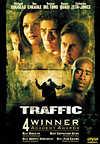Traffic
USA Entertainment
Cast: Don Cheadle, Benecio Del Toro, Michael Douglas, Dennis Quaid, Catherine Zeta Jones
Extras: Behind the Scenes Featurette, Photo Gallery, Theatrical Trailers and TV Spots
Rating:
Based on a BBC miniseries and sometimes playing like a $40 million episode of "Law and Order," "Traffic" interweaves three separate stories, representing various levels of the drug trade food chain. Actually, the film shows two nations fighting the war: the United States and Mexico. The first story introduces the battle perspective from south of the border, with Del Toro as Javier Rodriguez, a struggling Tijuana policeman continually thwarted by his own government in stopping the drug flow. Rodriguez and his partner Manolo learn that two major drug cartels are vying for control of the drug pipelines. Rodriguez lives a rough existence: his salary is $300 a month, he pays for his own handcuffs and sadly watches his peers advance through bribery and corruption.
The view from the American trenches comes from the second story featuring Michael Douglas as Robert Wakefield, an Ohio state justice named the new "drug czar" by the President to lead the national fight against the drug trade. While Wakefield naively urges his underlings to "think outside the box" in unraveling the chemical Gordian knot choking the country, he need not look any further than his own kitchen to see just how deep the drug problem cuts into the nuclear family: his daughter Caroline (Erika Christensen) is a heroin addict.
Soderbergh masterfully juggles these stories, never exactly crossing but always swirling around each other. Pacing is critical when cutting between interwoven but not interdependent plots. For its two and a half hour running time, the film just whizzes by. Despite the ensemble cast structure, Del Toro clearly emerges as the film’s emotional core, winning his Supporting Actor Oscar hands down. His Rodriguez is a moral man caught in a universe where ethical behavior only burdens. His conflict even invades his dreams: in the first scene, Rodriguez recalls a dream about his mother in a life-threatening situation, a chilling metaphor of the human toll in the drug war. Douglas’ Wakefield starts off pompous and literally innocent of the magnitude of the challenge facing him. His predecessor (James Brolin in one of the film’s many cameos) dismisses Wakefield’s praise of his accomplishments with a forlorn "I don’t think I made a difference." When he discovers his daughter’s addiction, he blames anybody or anything that will take away the pain of feeling like an accomplice.
As photographed by Peter Andrews (with Soderbergh frequently running camera), the translation of "Traffic" from film to DVD presented numerous challenges. Each of the stories has an unique look; the Mexico scenes favor yellows and browns with grainy cinematography, the Wakefield section immerses characters in blues and grays, with the Ayala sub-plot the most "ordinary" in color scheme. The 1.85 <$16x9,anamorphic> transfer coalesces the disparate photographic styles into a consistently detailed image. I especially enjoyed the Mexico scenes; under other circumstances, the grainy picture would be cause to criticize the telecine colorist or the compression author. Here, one almost feels the sun beating down. When colors can break through, they are accurate and sharp. Deep black levels and excellent detail delineation are evident throughout the presentation. Fleshtones, when not obscured, look natural and the source elements display no blemishes or imperfections whatsoever. Despite the gritty image and complex hues, digital or compression artifacts are happily missing.
The film is in English, with big chunks spoken in Spanish with English subtitles. The Subtitle menu offers a choice of "Original Presentation" (with explanation), Spanish (captions occur only in the English language sections), French and English (default for entire film).
Three trailers, five TV spots and a documentary constitute the extras. Despite the wishes of many fans, there is no <$commentary,commentary track> by Soderbergh or anyone else from the film. (Contrary to a growing perception, <$commentary,commentary track>s are not a "defacto" accessory for all DVD releases.) The U.S. teaser trailer plays the best, prominently highlighting the tag line "No one gets away clean." The U.S. theatrical trailer and the German (?) trailer are identical, giving away big chunks of plot and character surprises. The TV spots emphasize action, the critical raves and in one instance focusing solely on the teenage Caroline Wakefield character. (Studios don’t market to underage demographics, do they?)
I can’t imagine watching "Traffic" repeatedly over the years. But I also can’t imagine not having this film in my library. It’s a difficult, challenging film that will hopefully one day become a time capsule of a long-ended era.
[Erratum by the reviewer: "Several readers have pointed out my error of separating Peter Andrews, the Director of Photography, from the director Steven Soderbergh. In fact, Peter IS Steven, as he was required to use another name for the credits. The DVD makes no reference to this and in the documentary you see Soderbergh running camera. Hence my deduction that Soderbergh was a camera operator for the DP Peter Andrews. Looks like the cover name worked! Mea culpa."]







